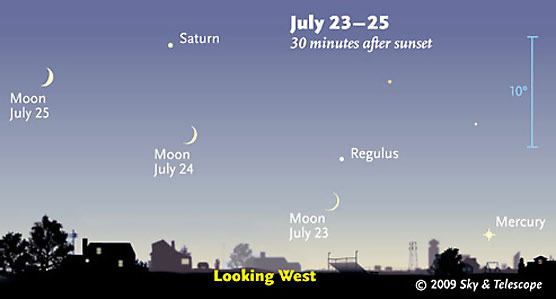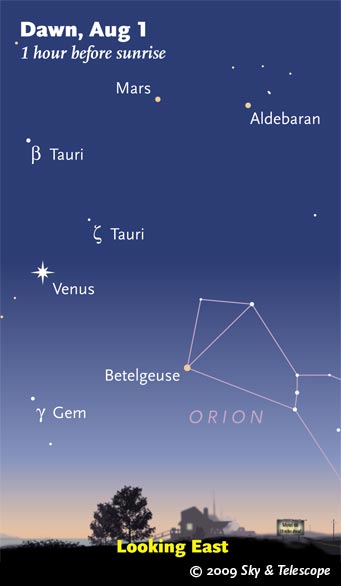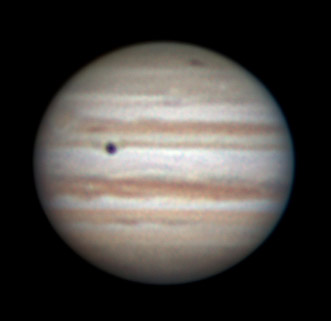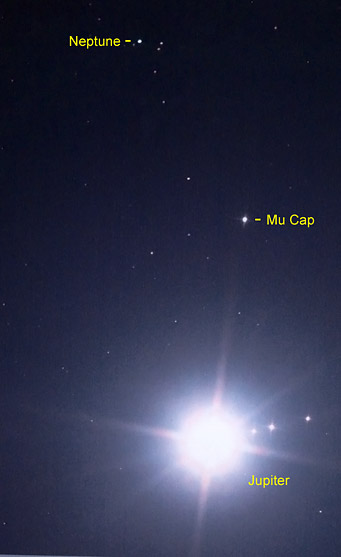Some daily events in the changing sky for July 24 – August 1.

After sunset, the waxing crescent Moon helps guide the way to Saturn, Regulus, and Mercury. Binoculars help when you're looking for faint things in a sky this bright. (The Moon is positioned for a skywatcher near the middle of North America. In Europe, move each Moon symbol a quarter of the way toward the one for the previous date. In the Far East, move it halfway. The blue 10° scale is about the size of your fist held at arm's length.)
Sky & Telescope diagram
Friday, July 24
Saturday, July 25
Sunday, July 26
Monday, July 27
Tuesday, July 28
Wednesday, July 29
Thursday, July 30

Venus outshines all else in the eastern sky as dawn begins. Mars is more on a par with some of the bright stars in this early preview of "winter" constellations.
Sky & Telescope diagram
Friday, July 31
Saturday, August 1
Want to become a better amateur astronomer? Learn your way around the constellations. They're the key to locating everything fainter and deeper to hunt with binoculars or a telescope. For an easy-to-use constellation guide covering the whole evening sky, use the big monthly map in each issue of Sky & Telescope, the essential magazine of astronomy. Or download our free Getting Started in Astronomy booklet (which only has bimonthly maps).

The Pocket Sky Atlas plots 30,796 stars to magnitude 7.6 — which may sound like a lot, but that's less than one star in an entire telescopic field of view, on average. By comparison, Sky Atlas 2000.0 plots 81,312 stars to magnitude 8.5, typically one or two stars per telescopic field. Both atlases include many hundreds of deep-sky targets — galaxies, star clusters, and nebulae — to hunt among the stars.
Sky & Telescope
Once you get a telescope, to put it to good use you'll need a detailed, large-scale sky atlas (set of charts; the standards are Sky Atlas 2000.0 or the smaller Pocket Sky Atlas) and good deep-sky guidebooks (such as Sky Atlas 2000.0 Companion by Strong and Sinnott, the more detailed and descriptive Night Sky Observer's Guide by Kepple and Sanner, or the classic Burnham's Celestial Handbook). Read how to use them effectively.
Can a computerized telescope take their place? I don't think so — not for beginners, anyway, and especially not on mounts that are less than top-quality mechanically. As Terence Dickinson and Alan Dyer say in their Backyard Astronomer's Guide, "A full appreciation of the universe cannot come without developing the skills to find things in the sky and understanding how the sky works. This knowledge comes only by spending time under the stars with star maps in hand and a curious mind." Without these, "the sky never becomes a friendly place."
More beginners' tips: "How to Start Right in Astronomy".
This Week's Planet Roundup

Jupiter's impact scar is the small dark mark in the planet's South Polar Region (top). The black dot on the edge of the South Equatorial Belt is the shadow of Callisto. Note the Great Red Spot just about to rotate out of sight on the celestial west limb (left). Sky & Telescope's Sean Walker used a 14.5-inch reflector for this stacked-video image 8:45 UT July 23, 2009.
The impact mark is near System II longitude 210°. To find the times of its future central-meridian crossings, add 2 hours and 6 minutes to our listed times of the Great Red Spot's transits. At least that's its approximate location; it may be moving a bit in longitude.
S&T: Sean Walker
Mercury (about magnitude –0.6) is having a poor apparition deep in the glow of sunset. Look for it very low in the west-northwest in bright twilight, as shown at the top of this page. Binoculars help. Watch Mercury closing in fast on fainter Regulus, to Mercury's upper left. They'll be just 0.6° apart on the evening of August 2nd.
Venus and Mars (magnitudes –4.0 and +1.1, respectively, both in or near Taurus) are in the east during dawn. Venus is a dazzler; Mars, well to Venus's upper right near Aldebaran, is 110 times fainter. They're moving farther apart: from 13° to 16° separation this week.
Aldebaran, similar to Mars in both brightness and color, twinkles about 5° or 6° to Mars's lower right or right. Higher above them are the Pleiades. Far left of them shines bright Capella. And look lower right of Venus for Orion.
Jupiter (magnitude –2.8, in Capricornus) shines low in the east-southeast during twilight. It's higher in better telescopic view around midnight.
The impact on Jupiter. A black dust mark, like those of the Comet Shoemaker-Levy 9 impacts in 1994, appeared suddenly in Jupiter's south polar region around July 18th. It's now spreading out. Backyard observers have been spotting it in 4-inch scopes during moments of good atmospheric seeing. See our article.

On the morning of July 9th, Bob Kimmel of Rockledge, Florida, took this image of Jupiter (overexposed) and Neptune when they were 1/2° apart. Why are they so different in brightness? Jupiter is a bigger planet, but mostly it's because Jupiter is closer to the Sun (so it gets lit more brightly) and closer to Earth.
Kimmel used an 8-inch f/5 Newtonian reflector with a Canon D20a DSLR camera body on his back patio. This is an unguided 20-second exposure at ISO 3200.
Bob Kimmel
Saturn (magnitude +1.1, in Leo) is getting low in the west after sunset, as shown at the top of this page. Look early! Saturn's rings are narrowing, appearing only 2° from edge on. And they're getting very dim. The rings turn edge-on to the Sun and go black on August 10th. They turn edge-on to Earth on September 4th, but by then Saturn will be lost in the sunset.
Uranus (magnitude 5.8, just below the Circlet of Pisces), is high in the south before dawn.
Neptune (magnitude 7.8, in Capricornus) remains about 1½° from Jupiter, but it's 17,000 times fainter. See our finder charts for Uranus and Neptune.
Both of these outermost planets show a very pale blue-green tint in a medium-size to large telescope, if your eye is particularly sensitive to color. Otherwise, or in a smaller telescope, they're basically gray.
Pluto (14th magnitude, in northwestern Sagittarius) is highest in the south just after dark. See the finder chart in the June Sky & Telescope, page 53.
All descriptions that relate to your horizon or zenith — including the words up, down, right, and left — are written for the world's mid-northern latitudes. Descriptions that also depend on longitude (mainly Moon positions) are for North America. Eastern Daylight Time (EDT) equals Universal Time (also known as UT, UTC, or GMT) minus 4 hours.
"Rational and innocent entertainment of the highest kind."
— John Mills, 19th century Scottish manufacturer and founder of Mills Observatory, on amateur astronomy.
To be sure to get the current Sky at a Glance, bookmark this URL:
http://SkyandTelescope.com/observing/ataglance?1=1
If pictures fail to load, refresh the page. If they still fail to load, change the 1 at the end of the URL to any other character and try again.
 0
0
Comments
You must be logged in to post a comment.